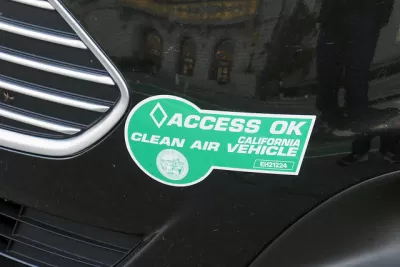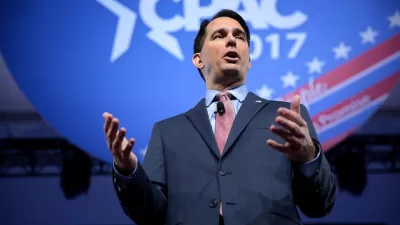Ozone pollution is worsening in five counties in Southern California, and the Air Quality Management District doesn't know why.

"Southern California's ozone pollution has worsened over the last two years, even as regulators say emissions are declining," reports Tony Barboza, who covers air quality and the environment with a focus on Southern California for the Los Angeles Times, on Nov. 15.
Ozone, the harmful gas in smog that inflames the lungs and triggers asthma attacks and other health problems, has violated federal health standards 145 days this year across Los Angeles, Orange, Riverside and San Bernardino counties, air monitoring data show. That’s up from 132 ozone violation days last year and 113 in 2015.
The South Coast Air Quality Management District, which regulates air quality in most of the four-county region, points to hotter temperature and inversions which trap pollution close to the ground. Public health and environmental groups disagree, questioning whether the emissions reductions estimates are accurate, and wanting the district to get tougher on stationary source emitters, like power plants and refineries.
Emissions dropping
Air quality officials say their projections show emissions of smog-forming pollutants continue dropping dramatically. And as mandates for cleaner cars and trucks continue to kick in, they expect ozone levels to decline over the long term.
Is climate change to blame?
Regulators and scientists say it is too soon to say whether climate change is driving recent increases in California smog. Researchers predict global warming will complicate efforts to clean air pollution by increasing the number of hot days, which speed up the photochemical reactions that generate ozone. But a few years of data is not enough to detect the fingerprints of global warming, they say
Ozone pollution difficult to regulate
Unlike other forms of air pollution, ozone, or smog, is formed in the lower atmosphere in the presence of heat and sunlight. Reducing ozone means reducing emissions of the two main contributors, nitrogen oxides (NOx) and volatile organic compounds.
Cut them in the wrong proportion and you may see no ozone reduction at all or even an increase, said Michael Kleeman, professor of civil and environmental engineering at UC Davis.
At the same time, both the quantity and intensity of heat and sunlight exacerbate ozone formation, so there are lots of variables to consider.
Transformation of transportation sector
Regulators say cleaning the air to federal standards will require a massive transformation of California’s transportation sector, which releases most of the state’s pollution. Gas and diesel engines must be replaced with zero- and near-zero-emission battery electric and hydrogen fuel cell engines and other emerging technologies.
That's fodder for Assemblyman Phil Ting (D-San Francisco) who plans to introduce legislation in February to ban sales of passenger vehicles powered by gasoline and diesel fuel by 2040.
The region's largest source of emissions, the ports of Los Angeles and Long Beach, are headed in that direction with the adoption of the Clean Air Action Plan (pdf) earlier this month. It encourages "the phase-out of diesel trucks in favor of natural gas and, ultimately, zero-emissions trucks and cargo-handling equipment over the next two decades," reported Barboza on Nov. 2.
Projections show most of the 17,000 trucks serving the ports becoming near-zero, or natural gas-fueled, by 2024. Zero-emissions trucks would become the majority by 2036.
FULL STORY: Southern California smog worsens for second straight year despite reduced emissions

Study: Maui’s Plan to Convert Vacation Rentals to Long-Term Housing Could Cause Nearly $1 Billion Economic Loss
The plan would reduce visitor accommodation by 25,% resulting in 1,900 jobs lost.

Alabama: Trump Terminates Settlements for Black Communities Harmed By Raw Sewage
Trump deemed the landmark civil rights agreement “illegal DEI and environmental justice policy.”

Why Should We Subsidize Public Transportation?
Many public transit agencies face financial stress due to rising costs, declining fare revenue, and declining subsidies. Transit advocates must provide a strong business case for increasing public transit funding.

Paris Bike Boom Leads to Steep Drop in Air Pollution
The French city’s air quality has improved dramatically in the past 20 years, coinciding with a growth in cycling.

Why Housing Costs More to Build in California Than in Texas
Hard costs like labor and materials combined with ‘soft’ costs such as permitting make building in the San Francisco Bay Area almost three times as costly as in Texas cities.

San Diego County Sees a Rise in Urban Coyotes
San Diego County experiences a rise in urban coyotes, as sightings become prevalent throughout its urban neighbourhoods and surrounding areas.
Urban Design for Planners 1: Software Tools
This six-course series explores essential urban design concepts using open source software and equips planners with the tools they need to participate fully in the urban design process.
Planning for Universal Design
Learn the tools for implementing Universal Design in planning regulations.
Smith Gee Studio
Alamo Area Metropolitan Planning Organization
City of Santa Clarita
Institute for Housing and Urban Development Studies (IHS)
City of Grandview
Harvard GSD Executive Education
Toledo-Lucas County Plan Commissions
Salt Lake City
NYU Wagner Graduate School of Public Service




























